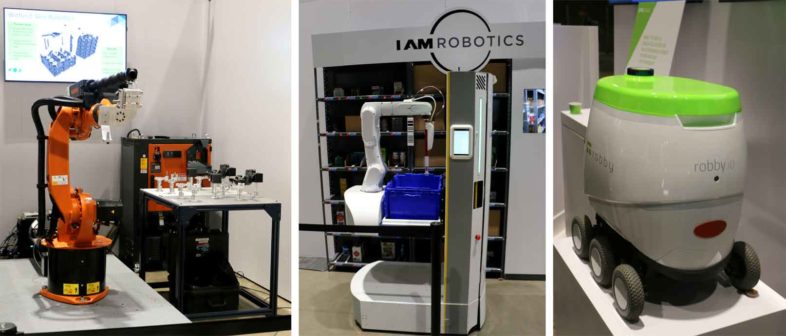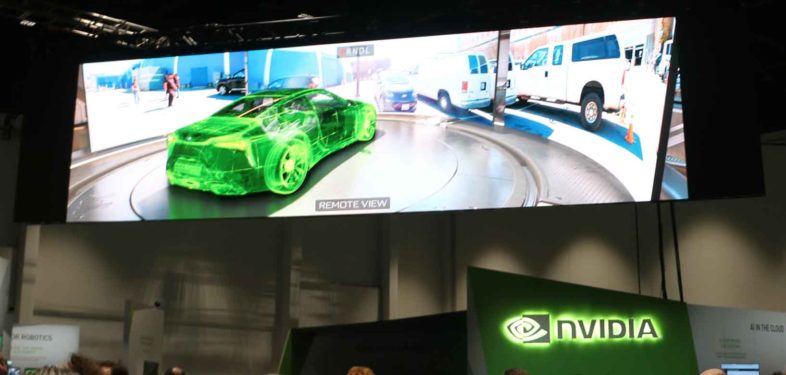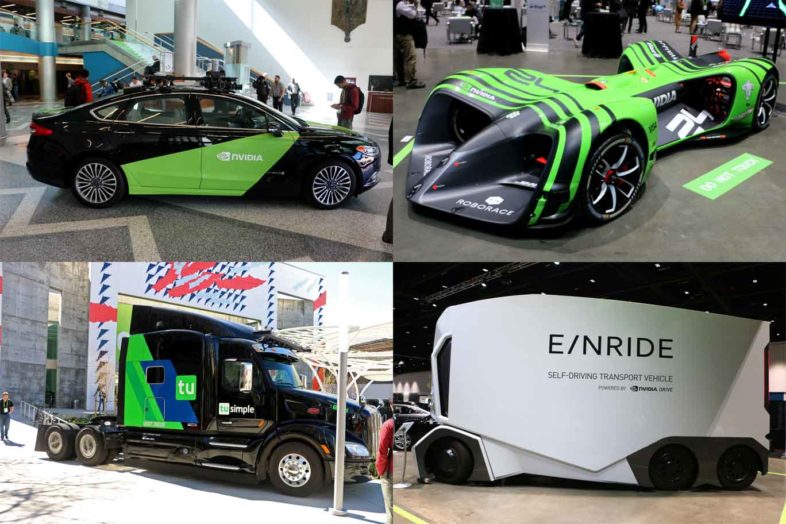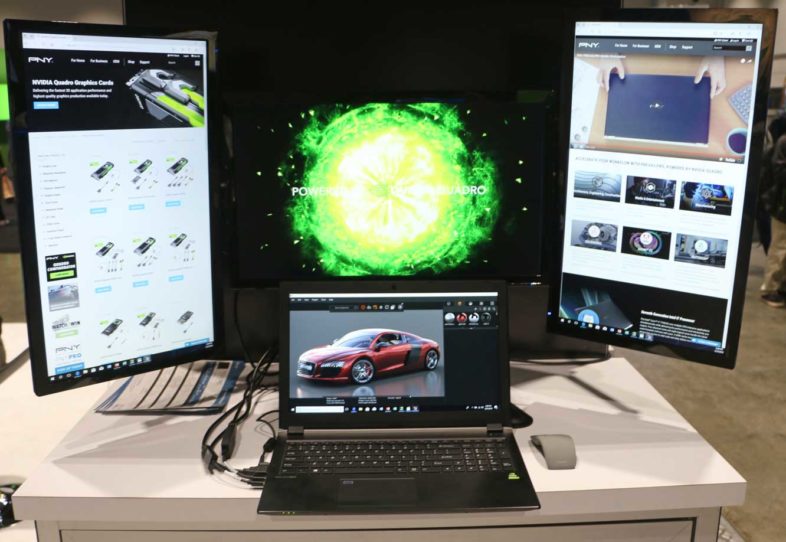I had the opportunity to attend GTC 2018, NVidia’s 9th annual technology conference in San Jose this week. GTC stands for GPU Technology Conference, and GPU stands for Graphics Processing Unit, but graphics makes up a relatively small portion of the show at this point. The majority of the sessions and exhibitors are focused on machine learning and artificial intelligence. And the majority of the graphics developments are centered around analyzing imagery, not generating it. Whether that is classifying photos on Pintrest, or giving autonomous vehicles machine vision, it is based on the capability of computers to understand the content of an image. Now DriveSim, NVidia’s new simulator for virtually testing autonomous drive software, dynamically creates imagery for the other system in the Constellation pair of servers to analyze and respond to, but that is entirely machine to machine imagery communication.
The main exception to this non-visual usage trend is NVidia RTX , which allows Ray-Tracing to be rendered in real time on GPUs. RTX can be utilized through NVidia’s OptiX API, as well as Microsoft’s DirectX Ray-Tracing API, and eventually through the open source Vulkan cross platform graphics solution. It integrates with NVidia’s AI Denoiser to utilize predictive rendering to further accelerate performance, and can be utilized in VR applications as well.
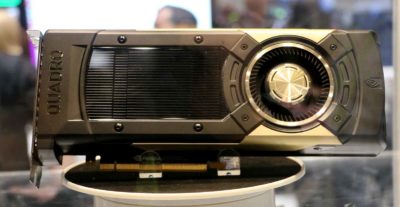 NVidia RTX was first announced at the Game Developers Conference last week, but the first hardware to run it was just announced here at GTC, in the form of the new Quadro GV100. This $9000 card replaces the existing Pascal based GP100 with a Volta based solution. It retains the same PCIe form factor, the quad DisplayPort 1.4 outputs, and the NV-Link bridge to pair two cards at 200GB/s, but jumps the GPU RAM per card from 16GB to 32GB of HBM2 memory. The GP100 was the first Quadro offering since the K6000 to support double precision compute processing at full speed, and the increase from 3584 to 5120 CUDA cores should provide a 40% increase in performance, before you even look at the benefits of the 640 Tensor Cores.
NVidia RTX was first announced at the Game Developers Conference last week, but the first hardware to run it was just announced here at GTC, in the form of the new Quadro GV100. This $9000 card replaces the existing Pascal based GP100 with a Volta based solution. It retains the same PCIe form factor, the quad DisplayPort 1.4 outputs, and the NV-Link bridge to pair two cards at 200GB/s, but jumps the GPU RAM per card from 16GB to 32GB of HBM2 memory. The GP100 was the first Quadro offering since the K6000 to support double precision compute processing at full speed, and the increase from 3584 to 5120 CUDA cores should provide a 40% increase in performance, before you even look at the benefits of the 640 Tensor Cores.
Hopefully we will see simpler versions of the Volta chip making their way into a broader array of more budget conscious GPU options in the near future. The fact that the new NVidia RTX technology is stated to require Volta architecture CPUs, leads me to believe that they must be right on the horizon. (But admittedly I believed that after last year’s GTC as well, based on the rapid roll out of Pascal based chips to all product segments.) Interestingly, the combination of AI based de-noising to accelerate ray-tracing, the presence of Tensor cores in Volta architecture, and the Volta requirement for RTX, leads me to the possible conclusion that Tensor cores may not be cut from the cheaper versions of the chip, the way that double precision cores have been since Kepler. And that could explain how all of the currently released implementations of Volta (Tesla, Titan, and Quadro) have every core enabled.
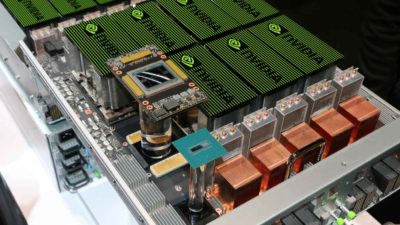 NVidia also announced a new all in one GPU super computer the DGX-2, which supports twice as many Tesla V100 GPUs (16) with twice as much RAM each (32GB) compared to the existing DGX-1. This provides 81920 CUDA cores addressing 512GB of HBM2 memory, over a fabric of new NV-Link switches, as well as Dual Xeon CPUs, Infiniband or 100GbE connectivity, and 32TB of SSD storage. This $400K super computer is marketed as the world’s largest GPU.
NVidia also announced a new all in one GPU super computer the DGX-2, which supports twice as many Tesla V100 GPUs (16) with twice as much RAM each (32GB) compared to the existing DGX-1. This provides 81920 CUDA cores addressing 512GB of HBM2 memory, over a fabric of new NV-Link switches, as well as Dual Xeon CPUs, Infiniband or 100GbE connectivity, and 32TB of SSD storage. This $400K super computer is marketed as the world’s largest GPU.
NVidia and their partners had a number of cars and trucks on display throughout the show, showcasing various pieces of technology that are being developed to aid in the pursuit of autonomous vehicles.
Also on display in the category of “actually graphics related,” was the new Max-Q version of the mobile Quadro P4000, which is integrated into PNY’s first mobile workstation, the Prevail Pro. Besides supporting professional VR applications, the HDMI and dual DisplayPort outputs allow a total of 3 external displays up to 4K each. It isn’t the smallest or lightest 15″ laptop, but it is the only system under 17″ I am aware of that supports the P4000, which is considered the minimum spec for professional VR implementation.
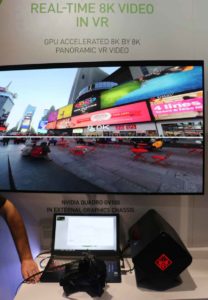 There are of course lots of other vendors exhibiting their products at GTC. I had the opportunity to watch 8K stereo 360 video, playing off of a laptop with an external GPU. I also tried out the VRHero 5K Plus enterprise level HMD, which brings the VR experience to another whole level. Much more affordable is TP-Cast’s $300 wireless upgrade Vive and Rift HMDs, the first of many untethered VR solutions. HTC has also recently announced the Vive Pro which will be available in April for $800. It increases the resolution by 1/3 in both dimensions to 2880×1600 total, and moves from HDMI to Displayport 1.2 and USB-C. Besides VR products, they also had all sorts of robots in various forms on display. Clearly the world of GPUs has extended far beyond the scope of accelerating computer graphics generation, and NVidia is leading the way in bringing massive information processing to a variety of new and innovative applications. And if that leads us to hardware that can someday ray-trace in real time at 8K in VR, then I suppose everyone wins, as long as the crypto-currency miners don’t get all of the GPU’s first.
There are of course lots of other vendors exhibiting their products at GTC. I had the opportunity to watch 8K stereo 360 video, playing off of a laptop with an external GPU. I also tried out the VRHero 5K Plus enterprise level HMD, which brings the VR experience to another whole level. Much more affordable is TP-Cast’s $300 wireless upgrade Vive and Rift HMDs, the first of many untethered VR solutions. HTC has also recently announced the Vive Pro which will be available in April for $800. It increases the resolution by 1/3 in both dimensions to 2880×1600 total, and moves from HDMI to Displayport 1.2 and USB-C. Besides VR products, they also had all sorts of robots in various forms on display. Clearly the world of GPUs has extended far beyond the scope of accelerating computer graphics generation, and NVidia is leading the way in bringing massive information processing to a variety of new and innovative applications. And if that leads us to hardware that can someday ray-trace in real time at 8K in VR, then I suppose everyone wins, as long as the crypto-currency miners don’t get all of the GPU’s first.